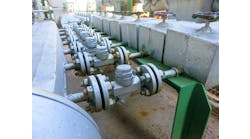Water positive can be defined as the concept where an oil refinery or chemical facility goes beyond simply conserving water and actively contributes to the sustainable management and restoration of water resources. This involves implementing practices and technologies that reduce water consumption, improve water quality, recycle water and enhance water availability. The goal is to leave a positive impact on water ecosystems and ensure more water is conserved and restored than is used or depleted. Strategies include process optimization, water recycling, efficient cooling technologies, leak detection and employee engagement. By implementing these measures, companies can conserve water, reduce costs and promote environmental stewardship with a more sustainable and environmentally conscious future.
Chemical facilities and oil refineries are significant consumers of water, using it for various processes such as cooling, steam generation, water washing and chemical reactions. However, with growing concerns over water scarcity, environmental regulations and operational costs, these industries need to minimize their water intake. Listed below are seven effective strategies chemical facilities and oil refineries can implement to reduce water consumption while maintaining operational efficiency and environmental sustainability.
1. Conduct a Water Audit and Pinch Analysis
The first step toward minimizing water intake is to conduct a comprehensive water audit and pinch analysis. This involves analyzing the water usage across different processes to identify areas of excess consumption and potential opportunities for water reuse. By understanding the water flow within the facility and pinpointing inefficiencies, companies can develop targeted strategies for water conservation. The pinch analysis allows for the identification of water streams that normally go to wastewater treatment but can instead be reused in another service.
2. Optimizing Process Efficiency
Key to reducing water consumption, optimizing process efficiency can be achieved through various measures, such as redesigning processes to minimize water requirements, optimizing reaction conditions to reduce solvent usage and implementing closed-loop systems for water recycling. Process optimization not only conserves water but also improves overall operational efficiency and reduces operational costs.
3. Implementing Water Recycling and Reuse Systems
This is one of the most effective ways to minimize water intake. Wastewater from various processes can be treated and recycled for use in cooling water. Some water can be redirected toward the reverse osmosis plant to prepare boiler feedwater. Technologies such as reverse osmosis, membrane filtration and biological treatment can be employed to treat wastewater to a quality suitable for reuse. By recycling water within the facility, companies can significantly reduce their reliance on freshwater intake. Even if the water cannot be recycled within the facility, other chemical plants in the same area may have use for this processed water.
4. Adopting Efficient Cooling Technologies
Cooling systems are major consumers of water. By adopting efficient cooling technologies such as dry cooling systems, air-cooled condensers and hybrid cooling towers, companies can significantly reduce water consumption. Hybrid cooling towers address the water lost in the air. This visible plume from cooling towers is essentially pure water vapor discharged from cooling towers during operation. It’s visible when the moist air mass leaving the tower is cooled below its dew point. This visible plume is most prevalent during winter when warmer, moist air mixes with colder ambient air. A visible plume discharged from a cooling tower isn’t an air pollutant and represents water loss.
In hybrid cooling towers, the dried and warmed air flow produced within the dry section mixes with the dried-out saturated air from the wet section to reduce plume formation. Additionally, optimizing cooling tower operations, implementing water-saving measures such as drift eliminators, cycle concentration control and utilizing alternative cooling mediums can further minimize water intake.
5. Invest in Leak Detection and Prevention
Undetected leaks in pipelines, valves and equipment can lead to significant water wastage. Investing in leak detection and prevention programs can help identify and repair leaks promptly, minimizing water losses and conserving resources. Advanced practices such as real-time monitoring systems and predictive maintenance can aid in early leak detection and prevention, reducing water consumption. In addition, any repair of steam leaks, for example, through poorly functioning steam traps, will not only save water but also energy.
6. Utilize Water-Efficient Equipment and Technologies
Choosing water-efficient equipment and technologies can help reduce water intake in chemical facilities. This includes selecting equipment with water-saving features, such as low-flow pumps, water-efficient reactors and closed-loop systems. Additionally, incorporating water-saving practices such as vacuum distillation, solvent recovery systems and advanced process control can further optimize water usage. These systems also reduce steam consumption, leading to less water intake and more energy savings.
7. Promote Employee Engagement and Awareness
Employee engagement is crucial for successful water conservation efforts. By providing training and raising awareness among staff about the importance of water conservation, best practices for water usage and the impact of their actions on water consumption, companies can foster a culture of conservation within the organization. Encouraging employees to identify and report water-saving opportunities can lead to continuous improvement in water management practices. Developing metrics and KPIs for water consumption can further assist operators in water conservation and also engage management in the ongoing success of water positivity and operational cost reduction.
Win at Environmental Stewardship
Minimizing water intake in chemical facilities is essential for sustainable operations, environmental stewardship and cost efficiency. By implementing these seven strategies, companies can achieve significant reductions in water consumption while maintaining operational efficiency and competitiveness in the market. With proactive measures and a commitment to sustainability, chemical facilities and oil refineries can contribute to water conservation and improved margins while improving environmental stewardship.



